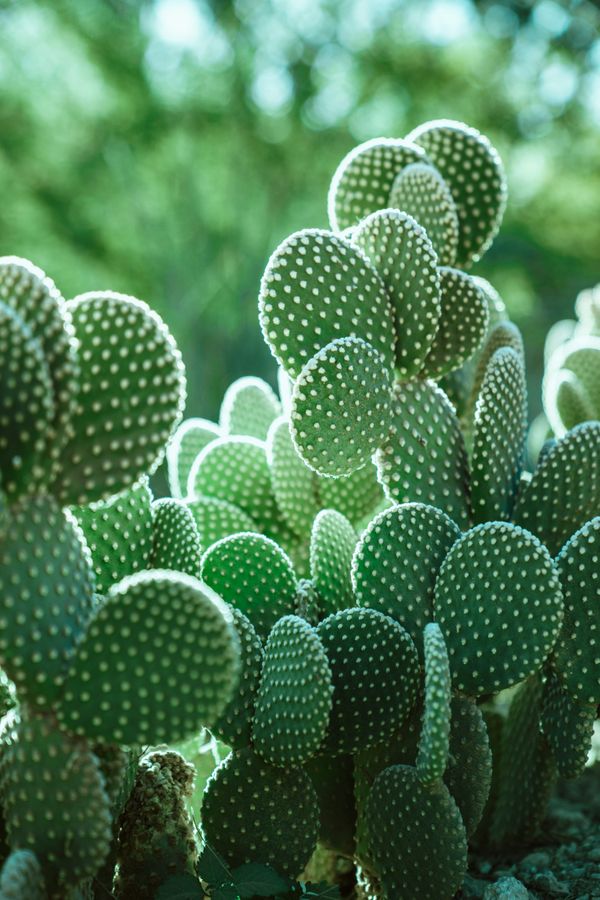Bunny Ear Cactus Care Guide
How to grow and care for Bunny Ear Cactus (Opuntia microdasys)
Opuntia microdasys, commonly known as the Bunny Ear Cactus, is a delightful addition to any indoor plant collection. Known for its distinctive pad-like stems and small, fuzzy glochids, it is a low-maintenance desert plant that mimics the appearance of bunny ears. Native to Mexico, this cactus thrives in dry conditions and brings a touch of the desert to your home, all while being relatively easy to care for, even for beginner gardeners.

Disclosure: This content includes affiliate links, which means we may earn a commission if you click on a link and make a purchase. As an Amazon Associate, we earn from qualifying purchases. This comes at no extra cost to you and helps offset the cost of running Leafwise. Please read our disclaimer for more info.
Table of Contents
Care
Light
Place your Bunny Ear Cactus where it can receive 6–8 hours of direct or very bright indirect sunlight per day. A south- or west-facing window is ideal. During winter dormancy, slightly reduced light is acceptable, but prolonged low-light conditions should be avoided. While some direct sunlight is beneficial, avoid intense midday rays to prevent scorching.
Watering
Water sparingly. During the growing season (spring and summer), water every 2–3 weeks depending on temperature and humidity. Allow the soil to dry out completely between waterings. In winter, reduce watering to once a month or less. Overwatering is a leading cause of root issues.
Temperature
Maintain indoor temperatures between 65°F and 100°F (18°C to 37°C) during the growing season. The plant is not frost-tolerant and should be protected from temperatures below 20°F (-6°C). Keep it away from drafts and avoid sudden temperature changes.
Soil
Use a well-draining cactus or succulent mix. For best results, combine equal parts potting soil, coarse sand, and perlite to ensure optimal drainage and aeration.
Fertilizing
Fertilize once a month during spring and summer using a balanced, water-soluble cactus fertilizer diluted to half strength. Signs of over-fertilization include browning tips or salt buildup on the soil. Stop fertilizing in fall and winter during dormancy.
Maintenance
Proper maintenance supports long-term health and appearance. Always handle with care, as the glochids can easily embed in skin and cause irritation. Use thick gloves or tweezers during handling or maintenance.
Pruning
Pruning is typically unnecessary. However, you may remove dead, damaged, or misshapen pads with clean, dry tools to maintain shape and prevent infections.
Cleaning
Dust can accumulate on the pads over time. Use a soft brush or cloth to gently clean them without disturbing the glochids.
Repotting
Repot every 2–3 years or when the plant becomes root-bound. Signs include roots emerging from drainage holes, the soil drying out quickly, or the plant becoming top-heavy. Repot in spring into a slightly larger pot with fresh, well-draining soil.
Propagation
By Pads
To propagate, use sterilized scissors to remove a pad during the summer when the plant is actively growing. Allow the cut end to callous over for several days. Then, plant it upright in dry cactus mix and water sparingly. Place in a warm, well-lit area. Roots should begin forming within a few weeks.
Common Issues
Pests
Mealybugs and spider mites are the most common pests. Look for webbing, sticky residue, or distorted pads. Improve airflow and inspect regularly. Treat infestations with insecticidal soap or neem oil, repeating every 7–10 days as needed.
Root Rot
- Symptoms: Mushy, discolored roots, foul-smelling soil, wilting or collapsing growth, and pads that shrivel or turn yellow or brown. Root rot may be mistaken for underwatering, so inspecting roots is essential.
- Causes: Caused by overwatering, poorly draining soil, or containers lacking drainage. Waterlogged roots lead to oxygen deprivation and fungal infections.
- Solutions: Unpot the plant and trim away all rotted roots using sterilized scissors. Let healthy roots dry for a few hours. Repot into clean, dry, well-draining soil in a container with drainage holes. Resume watering cautiously after new growth emerges.
Yellowing
Yellow pads are often a sign of overwatering or inadequate light. Move the plant to a brighter location and allow the soil to dry out fully before watering again.
